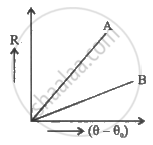Advertisements
Advertisements
प्रश्न
An ordinary electric fan does not cool the air, still it gives comfort in summer. Explain
उत्तर
An ordinary electric fan does not cool the air, still it gives comfort in summer because it circulates the air present in the room. Due to this, evaporation takes place and we feel cooler.
APPEARS IN
संबंधित प्रश्न
A body cools from 80 °C to 50 °C in 5 minutes. Calculate the time it takes to cool from 60 °C to 30 °C. The temperature of the surroundings is 20 °C.
The temperature of the atmosphere at a high altitude is around 500°C. Yet an animal there would freeze to death and not boil. Explain.
Newton's law of cooling is a special case of
A body cools down from 65°C to 60°C in minutes. It will cool down from 60°C to 55°C in
Answer the following question.
State Newton’s law of cooling and explain how it can be experimentally verified.
Solve the following problem.
A metal sphere cools at the rate of 0.05 ºC/s when its temperature is 70 ºC and at the rate of 0.025 ºC/s when its temperature is 50 ºC. Determine the temperature of the surroundings and find the rate of cooling when the temperature of the metal sphere is 40 ºC.
A metal sphere cools from 80 °C to 60 °C in 6 min. How much time with it take to cool from 60 °C to 40 °C if the room temperature is 30 °C?
A bucket full of hot water cools from 85 °C to 80 °C in time T1, from 80 °C to 75 °C in time T2 and from 75 °C to 70 °C in time T3, then ______.
Rate of cooling of a body is 0.4 °C/min when excess temperature is 20 °C. The proportionality constant is ______.
A metal sphere cools from 66° C to 57° C in 10 minutes and to 44° C in the next 10 minutes. The ratio of fall of temperature of first 10 minutes to next ten minutes is ____________.
A liquid with a certain surface area takes 10 minutes to cool from 80° C to 70° C. The time taken by it to cool from 80° C to 60° C is [The surrounding temperature being 40° C] ____________.
Newton's law of cooling leads to the expression:
A tub of hot water cools from 80°C to 75°C in time t1 from 75°C to 70°C in time t2, and from 70°C to 65°C in time t3 then:
Two circular discs A and B with equal radii are blackened. They are heated to the same temperature and are cooled under identical conditions. What inference do you draw from their cooling curves?

A cup of coffee cools from 90°C to 80°C in t minutes, when the room temperature is 20°C. The time taken by a similar cup of coffee to cool from 80°C to 60°C at a room temperature same at 20°C is ______.
Is the bulb of a thermometer made of diathermic or adiabatic wall?
According to Newton's law of cooling, the rate of cooling of the body is proportional to (Δθ), where Δθ is the difference between the temperature of the body and the surroundings, and n is equal to ______.
